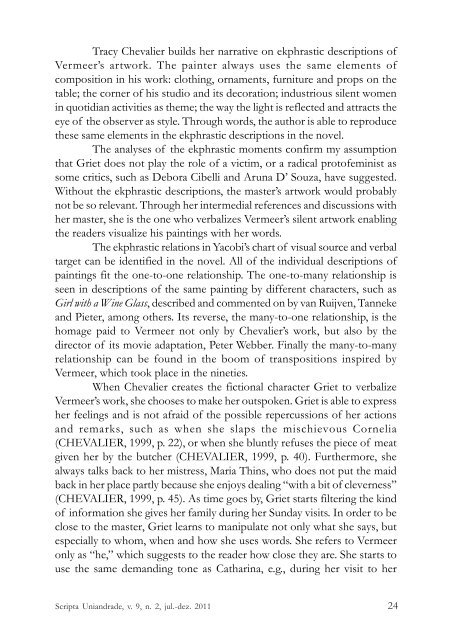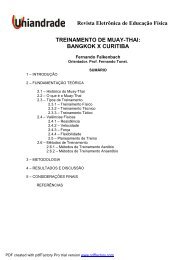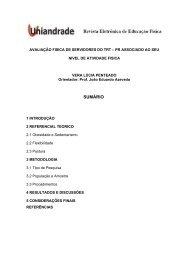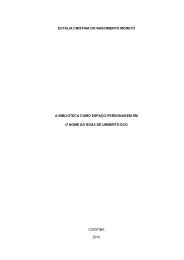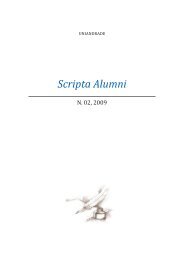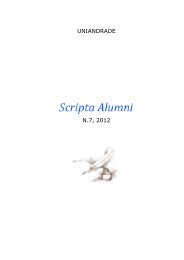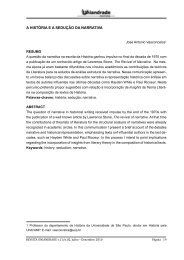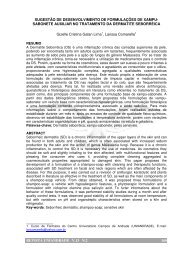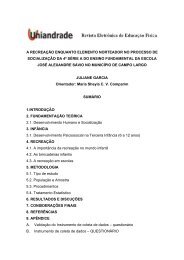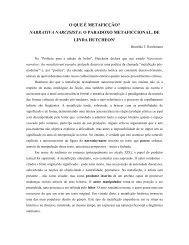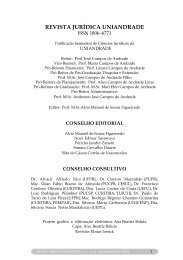Scripta 9_2_link_final.pdf - Uniandrade
Scripta 9_2_link_final.pdf - Uniandrade
Scripta 9_2_link_final.pdf - Uniandrade
Create successful ePaper yourself
Turn your PDF publications into a flip-book with our unique Google optimized e-Paper software.
Tracy Chevalier builds her narrative on ekphrastic descriptions of<br />
Vermeer’s artwork. The painter always uses the same elements of<br />
composition in his work: clothing, ornaments, furniture and props on the<br />
table; the corner of his studio and its decoration; industrious silent women<br />
in quotidian activities as theme; the way the light is reflected and attracts the<br />
eye of the observer as style. Through words, the author is able to reproduce<br />
these same elements in the ekphrastic descriptions in the novel.<br />
The analyses of the ekphrastic moments confirm my assumption<br />
that Griet does not play the role of a victim, or a radical protofeminist as<br />
some critics, such as Debora Cibelli and Aruna D’ Souza, have suggested.<br />
Without the ekphrastic descriptions, the master’s artwork would probably<br />
not be so relevant. Through her intermedial references and discussions with<br />
her master, she is the one who verbalizes Vermeer’s silent artwork enabling<br />
the readers visualize his paintings with her words.<br />
The ekphrastic relations in Yacobi’s chart of visual source and verbal<br />
target can be identified in the novel. All of the individual descriptions of<br />
paintings fit the one-to-one relationship. The one-to-many relationship is<br />
seen in descriptions of the same painting by different characters, such as<br />
Girl with a Wine Glass, described and commented on by van Ruijven, Tanneke<br />
and Pieter, among others. Its reverse, the many-to-one relationship, is the<br />
homage paid to Vermeer not only by Chevalier’s work, but also by the<br />
director of its movie adaptation, Peter Webber. Finally the many-to-many<br />
relationship can be found in the boom of transpositions inspired by<br />
Vermeer, which took place in the nineties.<br />
When Chevalier creates the fictional character Griet to verbalize<br />
Vermeer’s work, she chooses to make her outspoken. Griet is able to express<br />
her feelings and is not afraid of the possible repercussions of her actions<br />
and remarks, such as when she slaps the mischievous Cornelia<br />
(CHEVALIER, 1999, p. 22), or when she bluntly refuses the piece of meat<br />
given her by the butcher (CHEVALIER, 1999, p. 40). Furthermore, she<br />
always talks back to her mistress, Maria Thins, who does not put the maid<br />
back in her place partly because she enjoys dealing “with a bit of cleverness”<br />
(CHEVALIER, 1999, p. 45). As time goes by, Griet starts filtering the kind<br />
of information she gives her family during her Sunday visits. In order to be<br />
close to the master, Griet learns to manipulate not only what she says, but<br />
especially to whom, when and how she uses words. She refers to Vermeer<br />
only as “he,” which suggests to the reader how close they are. She starts to<br />
use the same demanding tone as Catharina, e.g., during her visit to her<br />
<strong>Scripta</strong> <strong>Uniandrade</strong>, v. 9, n. 2, jul.-dez. 2011<br />
24


